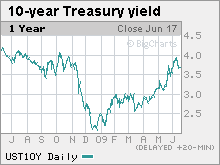Treasurys in a slide
Announcement of $104 billion in new debt sales and a stock rally combine to drive yields higher.
NEW YORK (CNNMoney.com) -- Treasury prices tumbled Thursday after the government announced $104 billion in debt auctions and mostly positive economic data sent stocks higher.
The benchmark 10-year note tumbled 31/32 to 94 12/32 and its yield edged up to 3.82%, still well below the 4% threshold hit last week. Bond prices and yields move in opposite directions.
The 30-year bond sank 1-12/32 to 94 12/32, and its yield rallied to 4.6%.
The 2-year note was down 5/32 to 99 9/32, and its yield edged up to 1.25%. The yield on the 3-month bill held steady at 0.18%.
Supply: The government, which has recently issued record amounts of debt to fund the economic stimulus effort, announced $104 billion in 2-, 5- and 7-year auctions scheduled for next week. Last week, the market absorbed $65 billion in debt.
The auction sizes were with market expectations. The government will sell $40 billion in 2-year notes Tuesday, $37 billion in 5-year notes Wednesday and $27 billion in 7-year notes Thursday.
"The market is focused on the pace of economic growth and the funding need," said Nick Kalivas, vice president of financial research at MF Global.
Economic data: Strong economic reports pushed stocks higher, attracting Treasury investors seeking higher returns.
The number of Americans filing for initial unemployment benefits rose 3,000 to 608,000 in the week ended June 13. However, continuing claims fell for the first time since early January, down 148,000 to 6,687,000 in the latest week available.
"The decline in the number of continuing claims is enough for the trading community to drive Treasury prices lower and yields higher," said Kevin Giddis, head of fixed income sales at Morgan Keegan, in his daily research note.
Two other reports added to positive sentiment. The Philadelphia Fed index, a reading on regional manufacturing, improved more than expected, and a component of future activity reached a 5-1/2 year high. An index of leading economic indicators (LEI) rose 1.2% in May, the Conference Board reported.
Giddis cautioned against being too optimistic about the speed of the recovery. "The economic freefall that started late last year may be decelerating and the sentiment in the market feels better," he wrote. "But let's not get too crazy with the idea that we are completely out of the woods."
Fed meeting next week: Investors are focusing on next week's Federal Reserve policy meeting, with market watchers waiting to see if the Fed will increase the size of its debt buyback program.
The government began its $300 billion program in March, to create demand and keep a lid on rising yields. The Fed repurchased $7 billion of debt Wednesday and $6.5 billion Tuesday.
With a couple of key government reports indicating inflation is largely in check, pressure for the Fed to raise its key lending rate has abated.
Lending rates: Bank-to-bank lending rates held at record lows in recent days, an indication of some relief for once-frozen pipelines of credit.
The three-month Libor held steady Thursday at a record low of 0.61%, according to Bloomberg.com. The overnight Libor rate was also unchanged at 0.26%.
The London Interbank Offered Rate -- or Libor -- is a daily average of rates that 16 different banks charge each other to lend money. The closely watched benchmark is used to calculate adjustable-rate mortgages. More than $350 trillion in assets are tied to Libor. ![]()



